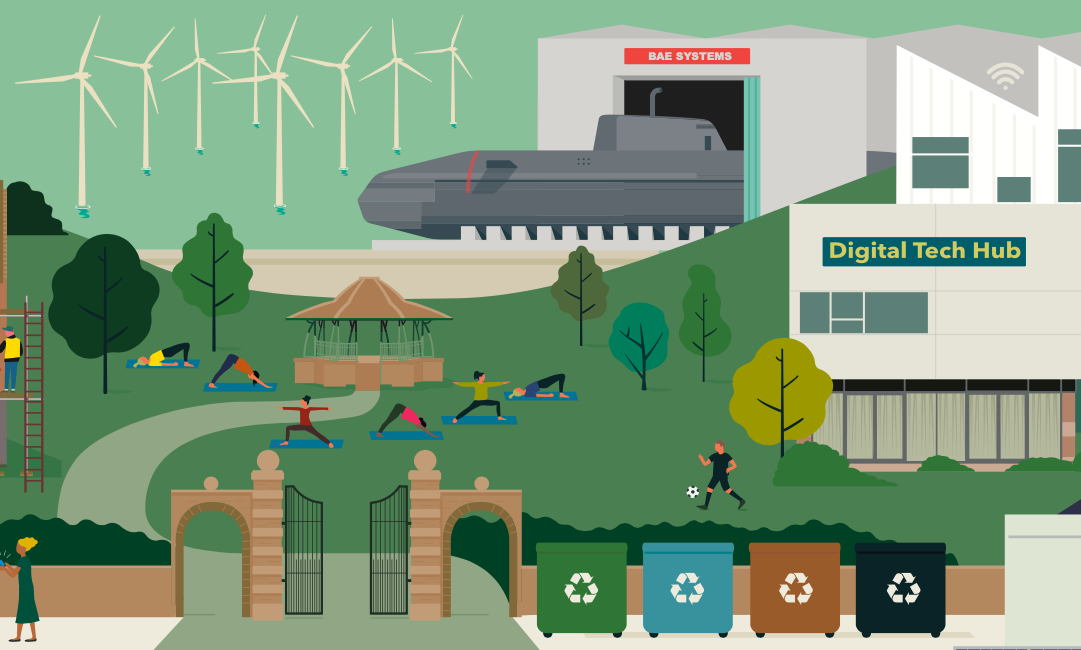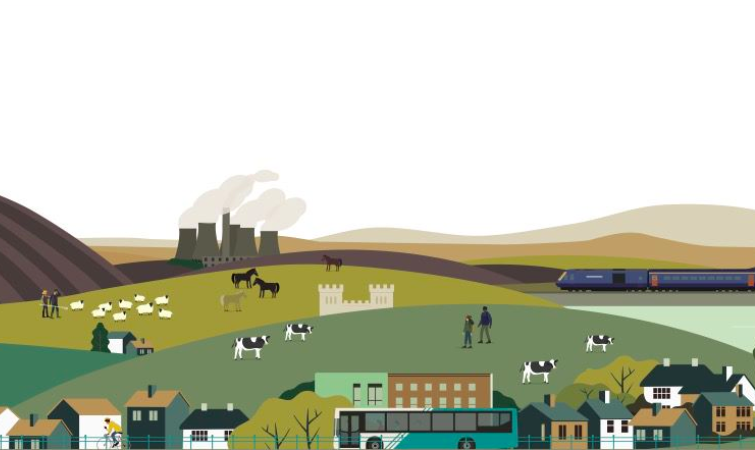The Green Audit: Can Boris Johnson Hit Net-Zero?
12 min read
Is the UK matching up to its climate pledges? With the clock ticking on targets, Georgina Bailey examines the government’s green credentials and takes stock of the opportunities and challenges ahead
“If we actually want to stop climate change, then this must be the year in which we get serious about doing so. Because the 2020s will be remembered either as the decade in which world leaders united to turn the tide, or as a failure.” So Boris Johnson told world leaders a virtual White House climate summit last month.
Along with some confusing references to “bunny-hugging”, the Prime Minister seemed to be laying down a gauntlet: the UK had set a new, ambitious target of 78 per cent reduction in CO2 emissions by 2035 compared to 1990, including emissions from international shipping and aviation for the first time. What were other countries prepared to do?
His words echoed those of Lord Deben, chair of the Climate Change Committee (CCC), in his foreword to the Sixth Carbon Budget in December 2020 (which first recommended the 78 per cent target). “If policy is not scaled up across every sector; if business is not encouraged to invest; if the people of the UK are not engaged in this challenge – the UK will not deliver net-zero by 2050. The 2020s must be the decisive decade of progress and action.”
When considering the UK’s climate change progress, it is important to reflect on how much the green goalposts have moved: the world-leading 2008 Climate Change Act (which set up the CCC) set a goal of an 80 per cent reduction in emissions targets by 2050. The phrase “net-zero” was barely even in the lexicon.
As it stands, the UK’s carbon emissions have dropped by 41 per cent compared to 1990, sitting at 522MtCO2 per year.
"The UK is moving backwards when it comes to meeting its long-term climate targets"
However, while the more ambitious target is welcomed by climate experts, an analysis published last month by the think tank Green Alliance found government policies announced so far would deliver just 26 per cent of the necessary cuts to achieve the target of a 68 per cent reduction in CO2 emissions by 2030 (31MtCO2e rather than 118MtCO2e).
“There’s no doubt the UK government is beginning to grasp the scale and severity of the climate crisis,” says Chris Venables, head of politics at Green Alliance. “But it’s also true that the UK is moving backwards when it comes to meeting its long-term climate targets, and without urgent action now to green the economy over the next 10 years, those welcome green shoots won’t amount to very much at all.”
Mike Thompson, chief economist at the CCC, agrees there is currently a gap, with 60 per cent of the work to reach net-zero by 2050 needing to be done in the next 15 years. “There’s an awful amount of work still to do. But I don’t think it’s unreasonable that that’s where we are; that is the reality of the policy development process, actually. It’s a good place to start, by setting these clear ambitions.”
Those within government call the plans “rightly ambitious,” and point to last year’s Ten Point Plan for a Green Industrial Revolution and the busy year ahead for ministers on green issues: another seven strategies and policy papers are due to be published ahead of COP26 this November, with three already out.
With time ticking down, The House takes a deep dive into the opportunities and challenges facing the government across six green areas.

Transport (incl. surface transport, shipping and aviation)
Emissions contribution in 2019: 31.35 per cent
Reduction since 1990: No reduction in surface transport emissions, 88 per cent increase in aviation emissions, 21 per cent reduction in shipping.
"In the UK, only one to two per cent of journeys are made by bicycle, while 24 per cent of car journeys are under two miles"
Opportunities: The move to ban new petrol and diesel cars from 2030 has been widely welcomed, with cars currently accounting for 68 per cent of surface transport emissions. The challenge will now be in the delivery of electric vehicle (EV) charging point roll out, particularly for the one-third of UK homes without off-road parking, and increasing consumer confidence in EV charging availability.
Independent think tank, Bright Blue, has called for all petrol stations to be fitted with three rapid charge points, and schemes in The Netherlands could be a useful model for local authorities looking to support on-road charge points outside people’s homes.
Other challenges include encouraging earlier transition for fleet vehicles to become electric, as these will then move into the second-hand market, and ensuring HGVs are quick to follow electrification trends.
Challenges: A modal shift away from private vehicles to increased public transport use and active transport such as walking and cycling will require an ambitious reset in how both the government and the public relate to transport – in the UK, only one to two per cent of journeys are made by bicycle, while 24 per cent of car journeys are under two miles. Currently buses account for five per cent of journeys, but the CCC thinks this could be nine to 12 per cent by 2030.
On aviation, while work on Jet Zero accelerates, sustainable aviation fuels work only as “drop-in” fuels, and electric-powered commercial aviation on a large scale is highly unlikely to be achieved in the next 10 years. Reducing demand for flights is therefore a key factor in reducing emissions.
While demand has plummeted as a result of Covid-19 and is unlikely to return to previous levels until 2024, green groups have expressed concern about the proposed cut to air passenger duty and whether the government should be seen to be encouraging flying. Others, such as the IPPR, are calling for a policy of no airport expansion without clear signs of green innovation, and the possibility of frequent flyer levies.
Keep an eye on: Whether the government scraps the fuel duty freeze. Movement on road building commitments. The Transport Decarbonisation Plan expected later this year should contain details on plans for electric vehicles, and how DfT will encourage a modal shift in transport use, with a key role for local authorities in both.
Industry
Emissions contribution in 2019: 22.37 per cent.
Reduction since 1990: 52 per cent.
Opportunities: In its Industrial Decarbonisation Plan published earlier this year, BEIS stated that it expected a further reduction of industry’s carbon emissions by two-thirds by 2035. In its latest analysis, the Green Alliance praised the strategy’s short-term decarbonisation goals including measures to build markets for low-carbon products and energy efficiency improvements, with Mike Thompson of the CCC saying BEIS “was in the right ballpark” with its commitments on carbon capture and storage (two clusters by 2025, two more by early 2030s).
With the Treasury’s upcoming Net Zero Review and the government’s Net Zero Strategy, the government has a clear opportunity to further galvanise investment in industry’s net-zero transition, with the potential for incentives or grants provided to businesses. The government’s commitment to and enthusiasm for investing in R&D is also widely welcomed, as is support for transitioning from oil and gas.
Challenges: There has been a lack of commitment to the decarbonisation of steel, despite the CCC’s recommendation that ore-based steelmaking should be near zero-carbon by 2035. The replacement of the Industrial Strategy with Industrial Decarbonisation Plan also raised some eyebrows within the sector, and there is no new money announced in the plan.
Keep an eye on: HMT Net Zero Review. The Net Zero Strategy (expected pre-COP). A new Emissions Trading Scheme aligned with net-zero.

Buildings
Emissions contribution in 2019: 16.37 per cent.
Reduction since 1990: Direct emissions from buildings fell by 19 per cent from 1990 to 2015, and have been roughly the same since. Indirect emissions have reduced by about 10 per cent a year since 2009.
"Updates to the building regulations will mean that homes built from 2022 have 31 per cent less carbon emissions than the current standards"
Opportunities: The government has committed to getting all fuel-poor homes to Energy Performance Certificate (EPC) C by 2030, and has extended and increased support under both the Energy Company Obligation and Homes Upgrade Grant. The government has committed to installing 600,000 heat pumps per year by 2028 – the CCC has said this should be 600,000 in existing homes and an additional 300,000 per year in new homes (last year only 30,000 heat pumps were installed).
While the Future Homes Standard will ensure that all new homes will have to be built to the highest standards of air tightness and energy efficiency, reducing carbon emissions by 75 to 80 per cent compared to homes built now, this won’t come into place until 2025. Updates to the building regulations will mean that homes built from 2022 have 31 per cent less carbon emissions than the current standards.
Challenges: In 2019, around 19 million homes (70 per cent) were not yet at EPC C, leaving the government dramatically behind its target of all homes being EPC C by 2035. The administration of the Green Homes Grant is widely considered to be a failure, and has now been scrapped having only reached 10 per cent of its 600,000 homes upgraded target.
Some critics believe the plan was not long-term enough and therefore industry was not confident in taking the financial risk to upskill and hire new workers to deliver the upgrades. Lack of willingness to allow tradespeople into the home during Covid was another block. The mass installation of zero-carbon boilers from 2030 could also prove another technical challenge.
Keep an eye on: The Heat and Buildings Strategy (expected before the summer) is an opportunity to fill the current policy vacuum on upgrading energy efficiency in homes, and may set out plans on how to incentivise changes in consumer behaviour to become more energy efficient.
"Leaving the EU and Common Agricultural Policy presents massive opportunities for the government to set subsidy and incentive schemes that work for farmers and the environment"

Agriculture and land use
Emissions contribution in 2019: 12.43 per cent.
Reduction since 1990: 16 per cent in agriculture emissions, but little reduction in the last 13 years. Land use emissions have reduced by 43 per cent.
Opportunities: Leaving the EU and Common Agricultural Policy presents massive opportunities for the government to set subsidy and incentive schemes that work for farmers and the environment – so-called “public money for public goods” such as food and environmental protections. The Sustainable Farming Incentive pilot began last month (and will launch fully next year) and it is yet to be seen whether the proposals will go far enough.
Challenges: Commitments to plant 30,000 hectares of new trees in the UK are welcome, but environmentalists are concerned it may end up as monocultural planting (which is good for carbon capture, but less good for nature) rather that the right type of trees and management to encourage biodiversity. Current proposals for the ban on peatland burning cover only nine per cent of English peatland.
Keep an eye on: The England Tree Strategy. The England Peat Strategy. The Nature Strategy. Concerns about delays to the Environment Bill.
Power
Emissions contribution in 2019: 11.3 per cent.
Reduction since 1990: 62 per cent.
Opportunities: The near complete phase out of coal has been a major success story. In 2019, renewables provided 37 per cent of the UK’s power, and the government’s commitment to generating 40GW of energy in offshore wind by 2030 is widely welcomed. The UK is aiming for 5GW of low-carbon hydrogen production capacity by 2030, and will also be consulting on ending connections of new homes to the gas grid from 2025.
Changes in Contracts for Difference should provide long-term stability to motivate further investment in renewable energy sources, and the government has committed to continuing nuclear projects.
Mike Thompson, the CCC’s chief economist, says that although the government’s plans for four or more carbon capture and storage clusters around the country are not as ambitious in terms of megatonnes captured as the CCC might like, the ability to scale up once the infrastructure is in place will be crucial. The government says its ambition is to capture 10Mt of carbon dioxide a year by 2030.
Challenges: While power has been one of the major success stories, this is primarily down to the reduction in coal. Experts believe the next challenges will be building a transition away from oil and gas, developing battery technology for storage of renewables, and the suitability of “blue” and “green” hydrogen. Clear government signals on where it regards the future of power generation will be necessary to further stimulate private investment in new technologies.
Keep an eye on: The Cumbria coalmine decision. Government business models for carbon capture and storage, required to kickstart private investment. Next stages of the energy white paper. The Hydrogen Strategy.
"Waste management is widely regarded to be a stalled area of development from successive governments"

Waste
Emissions contribution in 2019: 6.11 per cent.
Reduction since 1990: 63 per cent, but stalled since 2014.
Opportunities: Waste management is widely regarded to be a stalled area of development from successive governments, although positive steps are now being taken to encourage higher design standards of goods, and to make white goods easier to repair.
There is action on tackling plastics usage, and encouraging recycling. Consultations have been held on extended producer responsibility for packaging, and a new Waste Prevention Plan has been published.
Challenges: There is uncertainty from both the CCC and the Green Alliance as to whether current government plans go far enough, and there have been delays in responding to consultations on waste previously. Managing waste also requires greater consumer understanding. Tackling increasing incineration of waste and plastics is an additional challenge.
Keep an eye on: Delays in the Environment Bill, and in responding to consultations of the implementation of the Waste and Resources Strategy.
All emissions data is taken from Green Alliance’s 2021 Net Zero Policy Tracker, based on the latest CCC emissions projections. This includes international aviation and shipping, updated peatland emissions and values for methane intensity.
